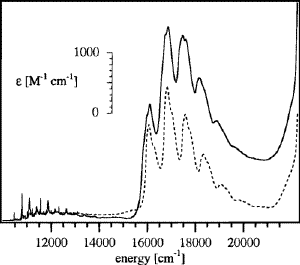Abstract of Publication No. 304
 Ralph P. Schenker, Thomas C. Brunold and Hans U. Güdel
Ralph P. Schenker, Thomas C. Brunold and Hans U. Güdel
Synthesis and Optical Spectroscopy of MnO42--Doped
Crystals of Cs2CrO4, SrCrO4,
CsBr and CsI
Inorg. Chem. 37, 918-927 (1998)
![]()
![]()
Abstract:
The first low-temperature absorption and luminescence spectra of
MnO42--doped crystals of
Cs2CrO4, SrCrO4, CsBr, and CsI are reported.
Single crystals of
Cs2CrO4:MnO42-, which
crystallize in the orthorhombic
b-K2SO4 structure, were grown from
basic aqueous solutions. An alkali-chloride flux composition was used to obtain
single crystals of SrCrO4:MnO42-
with the monoclinic monazite structure. Crystals of
CsBr:MnO42- and
CsI:MnO42- were prepared by slowly cooling the
melt. The site symmetry in SrCrO4 is C1, but the
deviations from D2 symmetry are small, and the spectra are
analyzed in the approximate D2 symmetry. The 2E
![]() 2T2 ligand-field
transitions are strongly c polarized, and in absorption only the
transition to the lowest-energy component of the split 2T2
state is observed with its origin at 10303 cm–1.
Luminescence is exclusively observed to the lower-energy component of the
2E state. By a combination of absorption and luminescence data, it is
shown that, in the cubic CsBr and CsI lattices,
MnO42- is partly incorporated in the form of
Cs2MnO4 crystallites. The observed nonexponential
luminescence decay for these systems indicates the existence of several
manganese(VI) species with different relaxation times. Within isomorphous host
lattices, a correlation is established between the temperature-quenching
behavior and the size of the M6+ host ion: the efficiency of
multiphonon relaxation processes increases with increasing ionic radius of
M6+.
2T2 ligand-field
transitions are strongly c polarized, and in absorption only the
transition to the lowest-energy component of the split 2T2
state is observed with its origin at 10303 cm–1.
Luminescence is exclusively observed to the lower-energy component of the
2E state. By a combination of absorption and luminescence data, it is
shown that, in the cubic CsBr and CsI lattices,
MnO42- is partly incorporated in the form of
Cs2MnO4 crystallites. The observed nonexponential
luminescence decay for these systems indicates the existence of several
manganese(VI) species with different relaxation times. Within isomorphous host
lattices, a correlation is established between the temperature-quenching
behavior and the size of the M6+ host ion: the efficiency of
multiphonon relaxation processes increases with increasing ionic radius of
M6+.